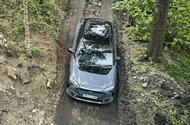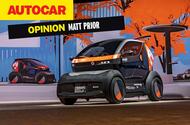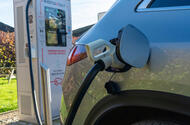Opinion
“Proton’s Return: Will Car Buyers Be Excited? | Giga Gears”
 Prior discusses how new brands can capture the attention of UK drivers with an element of familiarity
Prior discusses how new brands can capture the attention of UK drivers with an element of familiarity
I have a dim and distant memory of two Bullseye contestants winning the darts game show’s star prize, which, perhaps or perhaps not unusually, wasn’t a speedboat but a car.
As it was surprise-revealed to them (and this is where I wish I could be more confident in my memory, which yesterday couldn’t find my keys), I think one of the pair said slightly dismissively “it’s a Proton!”, to which host Jim Bowen replied “it doesn’t matter, it’s a car!”.
Alas, my YouTube searching hasn’t yet revealed whether my recollections are accurate. But how would you, do you think, feel about a Proton being revealed to you today? What does the name still mean to you, if anything?
I ask because we’ve learned that Proton co-owners Geely and DRB-Hicom Berhad are planning to invest billions into the brand as part of a major global expansion that will bring it back to the British market.
Part of the appeal for the owners is that while Geely is Chinese, Proton is Malaysian. It builds its cars in Malaysia, and exports from that country have softer established trade and import links with Europe than those from China.
But are you excited? Were you excited when MG returned to the UK? How do you feel about Omoda and Jaecoo? I tend to think that names matter. That MG means something, that Proton means something and that I wouldn’t fancy being the brand manager for Omoda and Jaecoo, which thus far don’t mean a jot.
At the recent Goodwood Festival of Speed, we interviewed Victor Zhang, the UK chief of Chery, which will soon be trying to sell its Omoda and apparently more upmarket Jaecoo cars here.
“In the UK, people still consider MG a British brand, right?” he posited, which I think is true. And I tend to think that, in addition to the price offering, knowledge and memory of the brand, even if it’s as dim as my recollection of Bullseye, matters to buyers.
Last year, MG took a UK market share of more than 4%, outselling Skoda and Peugeot and almost matching Hyundai.
Zhang doesn’t necessarily think that having unknown brands is a problem, though. In five years’ time, he would like to have “a similar market share to Kia”, which is currently the sixth-best-selling brand in the UK, with a 5.7% share.
Possible? It’s “quite challenging”, admitted Zhang, who thinks it’s best to aim high and miss than aim low and still miss. My initial reaction is to think Chery will miss by a lot, that names and brands matter. But is that because I’m too invested in the business?
Last year, Cupra sold almost as many cars in the UK as Seat, the brand that spawned it. And what did the average British car buyer know of Cupra five years ago? Likewise Polestar, which last year sold almost as many cars here as Lexus and Jaguar?
I wonder if I, you and people in and around the business do sometimes lose sight of what the average car buyer thinks.
I remember (because I took notes at the time) a spokesman at the launch of a Kia Rio in the early 2000s saying that the Hyundai group wanted to be a top-five global car maker in short time. Pfft, I thought, having spent time in the Rio. And, of course, last year it was the third-biggest.
So while I think that established brands are important, and somehow it feels important to me that I care about it, maybe I think about it too much and all most buyers are interested in are product, price and pleasant dealer experiences.
That said, I’m still not sure I’d want to try to sell a Yangwang.
Are new cars always better than old ones? | Giga Gears
 Matt Prior questions whether brands should be bolder with performance models as electrification takes hold
Matt Prior questions whether brands should be bolder with performance models as electrification takes hold
I used to think that ‘it’s better than the old one’ was one of the lazier tropes in this business.
New reviewers would get steered away from writing things like ‘they’ve improved it’, because if a company had spent a billion quid developing a new car using the latest technology, it would be fairly catastrophic if it wasn’t better than a vehicle they had designed a decade earlier.
So catastrophic that, with very few notable exceptions aside (such as Nissan’s 2010 Micra), it tended not to happen.
Last week, though, our cover featured one of those ‘man bites dog’ lines about the latest Mercedes-AMG C63: “It’s not as good as the old one”. Gulp.
This is worrying for companies that need to replace driver’s cars with ones that do the same thing but with powertrains they’re being manoeuvred into.
The old C63’s endearing V8 engine has been replaced by something with half as many cylinders, less charisma and more weight. And while I haven’t driven the new BMW M5 yet, it will come in at more than 2400kg.
We’ve got used to these cars being a certain way, and I don’t think it’s a guarantee that they will do the same thing, only better, in the future.
This brings me to cars like the new Hyundai Ioniq 5 N, of this week’s road test.
It doesn’t aim to do things better than were done by earlier hot Hyundais, like the i20 N and i30 N, because that’s no longer possible. Instead, it just sets out to do something entirely new, and it nails it.
I do wonder: if you can’t necessarily improve something, maybe you need to reinvent it.
Subaru’s EVs and Image Revamp Spark 1990s Success | Giga Gears
 Ex-McLaren special product boss wants to emulate brand's heyday successes from the 1990s
Ex-McLaren special product boss wants to emulate brand's heyday successes from the 1990s
After overseeing sales of the most exclusive JLR models at SVO and then the most exotic McLarens, including the Senna, Solus GT and Speedtail, a switch to running Subaru in the UK may not seem the obvious next move.
But Lorraine Bishton, who took the job in January, saw huge potential in leading a company that at its peak was one of the coolest brands in any industry in the UK – but in recent years had drifted into a state of mere existence.
For car-loving Bishton (pictured below), this was not only a chance to run a car company but also a chance to turn around a brand that, for all its troubles, is still well-loved by consumers.
That harks back to the late 1990s, when rally-bred Imprezas were the must-have performance cars, thanks to the exploits of Colin McRae and Richard Burns in the World Rally Championship.
But all good things eventually come to an end, and as the WRC-era cars gave way to the rise of Germans in the early 2000s, Subaru lost its sparkle and settled back into its other image: a maker of cars for geography teachers who wore jackets with leather arm patches.
That’s not a lazy stereotype on my part: remarkably, a Subaru executive offered that description unprompted at a Car of the Year event for the launch of the Solterra EV in 2022.

Bishton, one of Autocar’s Great Women in the Executive category for 2024, was headhunted for the role and started in January, where she found a “very well-loved brand” but one where “perhaps people are confused” by what it is.
“They speak fondly of Subaru but perhaps don’t know what it stands for,” she told me.
She wants to sell the Japanese brand as one that’s “safe, tough and fun”, with cars “that are an extension of the family” and “spec for spec, the best value in their segments”.
That latter point is one Subaru is already living up to, Bishton claimed.
“They’ve very capable but also comfortable and can go off-road. If you want a car that gives you the confidence to enjoy life and adventures, that’s what Subaru is.”
The ambitions for Subaru in the UK remain modest in absolute terms, with a goal of heading back towards its 1990s peak of around 12,000 units – although that’s still almost five times its 2023 volume.
In 2024, Subaru’s registrations were up 30% in the first half of the year, and Bishton spoke of a strong product pipeline, if also growth tailing off in the short term, due to more restricted supply.
Subaru is well ahead of the ZEV mandate target for 22% of total sales to be EVs, too, while the Solterra has also exposed it to a meaningful fleet audience for the first time in a generation. Just over a quarter of Subaru’s UK sales now come from fleet buyers.
Its 65 dealers have remained engaged with the brand throughout its recent fallow period, rooted and active in local communities by supporting local events. There are no plans for the agency model at Subaru to that end.
Subaru Corporation is a modest company. In January, it opened a new $200 million Subaru design and innovation centre in Japan to little fanfare.
As well as developing an $8 billion new generation of EVs that will make up the bulk of the Subaru range by the end of the decade (Bishton said the UK is respected and listened to and its “big say in products” belies its size), the site will further develop safety technology as part of Subaru’s laudable goal for zero deaths in its vehicles by 2030.
And while the geography-teacher image may be one that Subaru is keen to shake, its role as a responsible corporate citizen is being recognised in the right places.
Subaru was ranked second in the US in Forbes' best brands for social impact list, not just for car companies but across all sectors. It remains a big brand in the US, too, with sales of around 600,000 cars making this by far its biggest global market.
Bishton knows Subaru’s glorious past can be helpful in achieving success in the future. She said it was a “missed opportunity” to not talk about the brand’s motorsport activities and said Subaru UK will start to “celebrate its heritage” more as its next era of cars arrives – something she has experience with and a blueprint of from her time at McLaren.
After spending time with Bishton, you can see why she made the switch from Sennas to Subarus - and the potential for the brand's best days to still be ahead of it.
Renault Twizy: The Quadricycle Returns | Giga Gears

Mobilize Duo and a cargo variant called the Bento are set to arrive next yearWith the new Mobilize Duo around the corner, is there still a market for tiny EVs in the UK?
I’m pleased to see the Renault Twizy replacement will arrive in the UK, and I’m not a little surprised, given I didn’t think the previous one set the world alight when it was here the first time around.
But the Mobilize Duo and a cargo variant called the Bento are set to arrive next year, if a job advert for a product manager for the quadricycle is anything to go by. Please set pricing and keep an eye on Citroën Ami sales.
I’m pleased Renault’s quadricycle is making a comeback, though, because as far as fun goes – and that’s my primary decider on how much I like a car, given this is after all my hobby – the Twizy was right up there. It was terrific for whizzing around the town where I lived, with younger child in the back seat, squeaking between some bollards the back way into the supermarket car park to beat the queues.
It would even do 50mph or so, more on a downhill run with the wind at its back. That made it much more palatable than the Ami, which can do no more than 28mph and feels somehow more perilous, even though it’s an enclosed-cockpit vehicle.
The Twizy’s ride quality wasn’t too clever, because it was a relatively tall, light weight vehicle and I don’t suppose that was ever the developer’s priority, but it steered pretty well and handled like a kart.
As electric vehicle fun goes, I think my top handful includes a Hyundai Ioniq 5 N, the original Tesla Roadster, a Nissan Leaf with plastic back tyres and, in there somewhere, a Renault Twizy.
Not that fun was what it was designed for; it was just a by-product of light, funky design. Nor, obviously, was it meant to be subjected to an Autocar road test ’s performance testing equipment or go a distance. I had to load it onto a trailer to make it to our MIRA test facility, otherwise the journey would have taken me a day or two. And when I say that 17sec was a significant number during its acceleration tests, that’s because it took 17sec more to reach 50mph against the wind than it did with the wind behind it (for a 36sec average).
Still. I think I’d have liked one and would probably have used one quite a lot had it come with a range-extending little generator on the back to counter the 34-mile average range we recorded. The claimed range was 62 miles. This time around, the top speed is reckoned to be similar, but the range is 87 miles.
When the next generation of batteries reaches these vehicles (Nissan expects to introduce solid state batteries with double the energy density and three times the charge speed in 2028), I think it will be transformational for things like this. Anyway, I’m quite revved up for it. Which may be because it’s summer. For eight months of the year, put a coat and a grimace on.
Incidentally, while mistyping Twingo for Twizy for the nth time this morning without even realising it, I think for the first time I’ve noticed the similarities between the two vehicles’ names.
I’m not sure if the similarity is deliberate; it would make sense if it was. But it seems Twizy is short for ‘twin-easy’ and Twingo is a portmanteau of ‘twist, swing and tango’.
UK’s EV Charging Situation: Editor’s Perspective | Giga Gears
 Osprey CEO believes charging has been unfairly lumped in with the slump in demand for EVs
Osprey CEO believes charging has been unfairly lumped in with the slump in demand for EVs
“If you've read the press in the last year or two, the constant headline has been that there's not enough charging for electric vehicles. What has actually been happening on the ground in the last 18 months is a quite astonishing rollout of charging infrastructure.”
Ian Johnston, CEO of charging company Osprey, wants to change the narrative around the state of the charging network in this country.
He believes that charging has been unfairly lumped in with the slump in demand for the cars themselves. While gains in sales of EVs year-on-year have been marginal, Johnston told Autocar Business that the charging network has increased in size by 46% year-on-year and there are now more than 65,000 chargers operational in the UK. “And that rate and rollout is increasing all the time.”
He says charging companies like Osprey are focused on “funding and building this infrastructure ahead of the demand for EVs”, as whatever the peaks and troughs in demand for electric cars right now, the ultimate direction of travel and end game is clear.
Yet still, Johnston points to stigma and past truths about the charging network that could in turn be holding back the wider uptake of EVs.
“We've gone from a position of people worrying about queues or if a charger works, to now, in most cases, driving into big, high-power charging hubs,” says Johnston. He also pointed to the fact that consumers will no longer need multiple apps to pay for different chargers as standards are brought in to ensure a professional, reliable and easy-to-use service from the charging industry - with league tables showing the best and worst providers.
“The chargers installed in the last two years are reliable, easy to use, easy to pay; you just tap a bank card. The legacy chargers that are five, six or seven years old are such a tiny proportion of what's in the ground.”
Johnston says it was “disappointing” and “so unnecessary” that the lack of charging was one of the reasons the previous government pushed the ban on the sale of non-electric cars back to 2035.
“But the good news is we’ve addressed one of the major reasons not to make the switch. We now just need the [new] government to work with industry to help generate more retail demand [for the cars themselves].”
The charging network could be expanding at an even faster rate if planning permissions and highway permits (to connect to high-voltage power supplies often already in the roads) are granted sooner. Johnston says there are thousands of charging installations across the industry in the pipeline, and the network could almost double in size again.
To that end, Johnston says the new government is already positively engaging with the network through dialogue with industry body ChargeUK.
“What’s great is that the early noises from the government have been that they're really focused on fixing this as part of their drive to get Britain building again.
“This is not controversial infrastructure. We don't have an issue with NIMBYs here saying please don't build it; nearly everyone wants it. The problem is you've got to go through a process which is under-resourced and takes six to nine months to get planning permission.”
The charging industry is “not asking for money”, says Johnston, more an easier environment to operate in. Osprey alone is investing £40-50 million in installing new chargers and the total investment from companies into the charging sector stands at around £6 billion.
Much like the rush from car companies to launch new brands and products at huge losses in order to position themselves for future success in the next era, so too is there jostling among different charging companies to install networks at a loss, so as to be prepared for the projected demand increase.
The only money coming in is through the pence-per-kwh charged to a driver each time they charge, but even stripping out the return on investment on the installations themselves, the margins are still small as that revenue must cover the electricity cost to the supplier, as well as operational costs like call centres and servicing.
“It’s big money, proper business, but none of us are making a profit yet. The profit will come in the future.
“Today the main focus is just investing tens of millions every year on building infrastructure for when we get to our highest state of adoption. Today, we're at 3% of the vehicles on the road as electric; 80-90% of those will have a home charger, but on average people are still charging at least once a month on the public network.
“We haven't really even started seeing the true level of demand for charging. When that comes, that's when the network's will revert to profitability. But nobody's making a profit here today at all.
